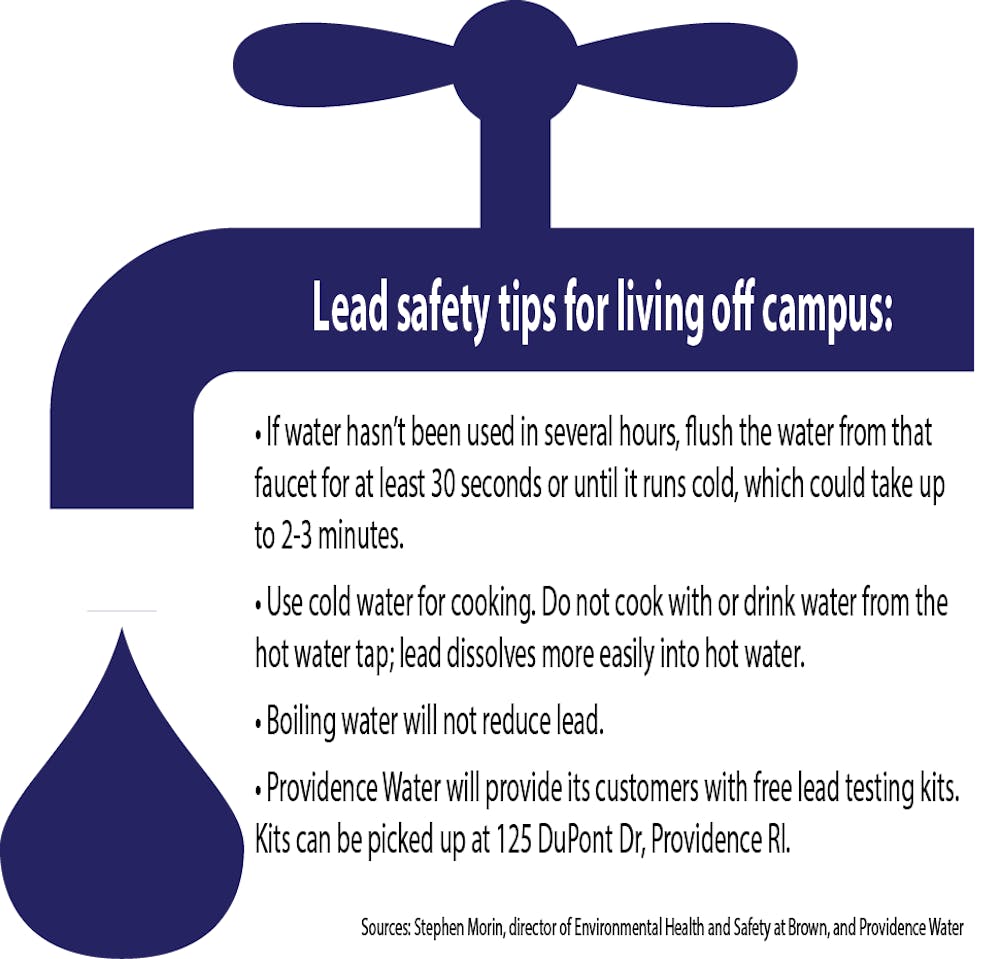A new study by University researchers confirmed that it is possible for household lead levels to be reduced more substantially than the Environmental Protection Agency currently mandates. The study follows Providence Water’s 2017 annual report, which revealed that Providence’s water exceeds the lead level guidelines set by the EPA. The University is currently testing water samples from campus buildings to see if they exceed EPA standards for drinking water for the first time since 2008, according to Director of Environmental Health and Safety Stephen Morin.
University study on household lead levels
Published in JAMA Pediatrics Aug. 27, the new study looked at 355 pregnant women and their children in Cincinnati from 2003 to the present. The research team implemented lead remediation techniques in the homes of about half of the women — including removing and replacing chipped lead paint and lead-painted window sills, installing lead-removing water filters and covering lead-contaminated soil with groundcover. The other half, the control group, received baby gates and injury prevention devices to prevent infants from direct exposure to lead.
While the researchers were unable to find a significant difference in blood lead levels among the wider group that received lead remediation intervention, there was a 31 percent reduction in lead levels among black children. Joseph Braun, associate professor of epidemiology at the School of Public Health and lead author of the study, is unsure why black children saw the largest improvement after treatment. Because black children are often exposed to a higher level of lead, the preventative measures may have made a larger impact, he said. Braun added that he is interested in conducting additional research about the relationship between income and lead exposure.
The study could help push the EPA to strengthen their guidelines for household lead levels, as it showed that achieving lower lead levels is possible, Braun said.
In addition to blood testing, the study looked at children’s behavior from one to eight years old. The only significant behavioral improvement between the control and treatment groups was a reduction in anxiety, Braun said.
Going forward, Braun said he would like to examine which types of remediation are most effective in reducing lead levels and explore the difference between lead exposure from water compared to dust.
Lead in Rhode Island
In Rhode Island, lead from dust and water are perennial issues. According to the Rhode Island Department of Health, 80 percent of homes in the state were built before 1978 and therefore contain a high level of lead paint. The state has exceeded the EPA’s recommended lead levels in the water “10 times or more” in the last 25 years, the Associated Press reported.
In the last decade, Providence Water has spent over $45 million mitigating lead damage, according to an Aug. 31 press release from the city utility company.
“Providence Water continues to evaluate our water treatment process to make the water less corrosive in an effort to reduce lead levels in homes that may have lead plumbing,” the statement read.
In Providence, both the 2016 and 2017 water quality reports showed lead exceedances above the EPA standards.
“It’s disturbing, but not at all surprising,” said Laura Brion ’04, executive director of Childhood Lead Action Project.
Brion, who advocates for lead safety in the state, said that Providence Water recently notified her that her office building in Federal Hill may have lead service lines. The Herald’s building at 195 Angell St. also received one of these notifications. Providence Water has placed the report in public locations, including the Sciences Library.
“I’m glad that Providence is reporting it out and that people are noticing it,” Brion said.
Providence Water’s brochures and letters, written in English and Spanish, encourage Providence Water customers to stop by their offices to pick up free water-testing kits. The literature also describes Providence Water’s no-interest, three-year loan program that provides loans for homeowners to replace private lead pipes with the guarantee that the company will replace the public lines.
Looking Forward
While headlines about lead, including those about Flint, Michigan, can ignite public concern, a lot has already been done to lower lead exposure, according to David Savitz, associate director of the Brown Center for the Study of Children at Risk and professor of epidemiology, pediatrics and obstetrics and gynecology.
“Levels that we’re concerned about (now), 10 years ago, we would have been happy about,” Savitz said, adding that with regulations such as removing lead from gasoline, the EPA has been able to gradually lower lead levels and make lead guidelines stricter.
“They set standards to be practical,” Savitz said, adding that no level of lead is known to be safe.
Interventions usually make subtler differences because lead levels are already generally much lower than before, he said, pointing to the study’s findings that black participants benefitted most from the remediation techniques while the group as a whole did not show significant reduction in blood lead levels.
But lead levels can always be lower, Savitz said, adding that Providence Water “certainly needs to lower levels to be in compliance” with EPA regulations.
Still, Savitz urged people not to panic about general low-level lead exposures in the United States.
“We’re concerned (about lead levels), not conveying a sense of terror,” he said.





